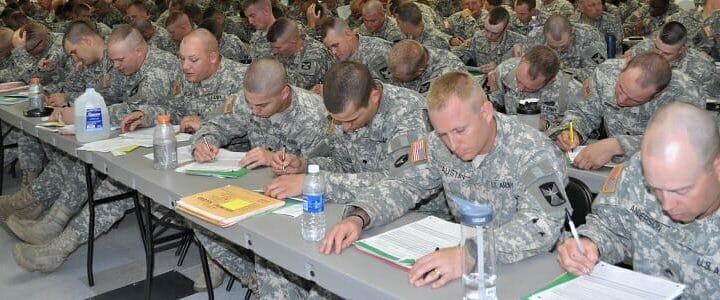Many servicemembers don’t want to spend up to four years going to school to get their degree once they have transitioned out of the military. Well, you may not have to.
With these three tips, you could not only speed up your time to a degree, but also save GI Bill benefits that could be used for further post-secondary training or reallocated to a family member.
Credit for Military Training
Military training courses longer than two weeks, awarded Military Occupational Specialties (MOSs), and professional development schools for enlisted and officers are just some of the ways to get transferable college credits. For example, physical training that is part of Basic and Individual Training can be worth up to 4 semester hours alone!
Most colleges require completing 60 to 65 credits for an associate’s degree and 120 to 130 for a bachelor’s degree. But by using the average number of credits for military service, an associate degree could be completed with as little as an additional 29 semester credits:
- Natural Science – 8
- English – 6
- Social Science – 6
- Humanities – 6
- Math – 3
To find out how many credits you have from military service, request a transcript from the JST website.
College-Level Examination Program (CLEP)
Some of the above credits needed for an associate degree could be awarded without having to actually take the class. Through the College-Level Examination Program (CLEP), if you pass the test, you get awarded the credits but don’t have to sit through the class. CLEP credits are accepted at more than 2,900 colleges and universities. Be sure to check to see if your school accepts CLEP credits first before taking the tests. Just type in the name of your school to see their CLEP policy and the credits they will award.
In all, CLEP offers 33 different tests in five different categories:
- Composition and Literature
- World Languages
- History and Social Sciences
- Science and Mathematics
- Business
Active-duty military members can usually take the tests for free, while veterans will have to pay for each test taken or use their Post 9/11 GI Bill to pay for the test. Each multiple-choice test takes on average between 90 and 120 minutes to complete and can be taken at more than 2,000 test centers across the United States.
Servicemembers Opportunity Colleges Degree Network System (SOS DNS)
More than 100 colleges and universities in the SOS DNS system offer associate’s and bachelor’s degree programs that can be taken either through distance learning or near (or on) post or base locations. The advantage is servicemembers can continue to work on their studies regardless of their location.
As part of the enrollment, a “home” school is chosen from the list of participating schools. That school agrees to accept up to 75% of the credit hours required for a degree as transfer credits. For example, if an associate degree requires 60 credits, up to 45 of those credits could be from a credit transfer from military credits awarded, CLEP, and other credits for classes previously taken. The remaining credits would come from courses taken.
Using these three tips not only saves hundreds of dollars of out-of-pocket costs and months of GI Bill benefits, but also a lot of time -thus getting you into the civilian workplace quicker.



